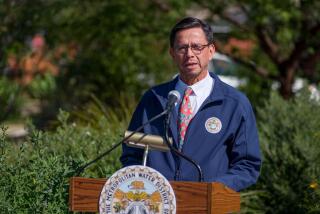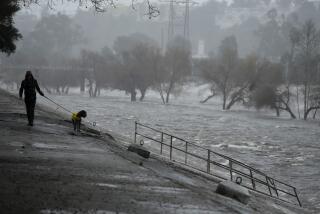Lessons of ‘Arborgeddon’
There’s a part of us that secretly likes disasters. Well, maybe not so secretly. That’s why Joan Didion’s famous riff on the Santa Ana winds — “the weather of catastrophe, of apocalypse” — is hauled out several times a year to explain what L.A. is all about. It’s our rep and we stand by it.
We chafe when our calamities are overshadowed by hurricanes in Miami or tornadoes in Joplin. So there was a thrill of recognition when the Nov. 30 windstorm added a new motif to our disaster portfolio: not just earthquakes, fires and mudslides — the possibility of a tree apocalypse.
The cleanup is still in the triage phase, and damage estimates are sketchy. But it’s clear that thousands of trees, from native oaks to exotic pines, were destroyed in the freakily frigid Santa Ana blow.
The next one could be worse. The L.A. Basin’s urban forest, with 20 million trees, is the largest in the nation, perhaps in the world, according to George Gonzalez, the city of L.A.’s chief forester. Mayor Antonio Villaraigosa wants to make it even bigger: His pet project, Million Trees LA, has already increased the arboreal inventory by 350,000.
But even as we plant more trees, we’re orphaning those we have. Two years ago, the city of Los Angeles cut the tree maintenance staff in half, reducing the tree-trimming schedule from once every 15 years to once every 40.
Now there’s talk of making homeowners do it instead — some residents are already pruning their own sidewalk trees.
Nor does the city have a rainy-day fund for when the next Big Wind hits and the trees we planted come crashing down around our ears. We’re looking for a handout from the state this time, and surely will do the same the next.
Not that we don’t love our trees. L.A. has its own tree-sitters, who go to jail to save a woodland. Folks here cry when thousand-year-old oaks fall.
But our attachment is nostalgic, a futile gesture to hold onto a lost California Eden that perhaps never existed, of leafy oaks and spreading grasslands. The reality is that our urban forest is an artificial landscape created to serve agricultural and development interests.
But stuck on the idea of trees as natural, we leave them to their own devices, like children sent outside at the cocktail hour.
Because of our fabulous climate, the trees will grow, but in heavy winds, damaged and stunted roots are not enough ballast for the heavy trunks swaying above them. Our forest is like so much glitter tossed on hard-packed desert sand.
Some say native trees are the answer. But think again. Native trees may have genetic protection against our normal environmental vicissitudes. But with so many planted in construction waste and over-watered, the only thing native about them is their names. Their roots are shallow and subject to rot. One of the most deadly threats to trees in this region is the lawn sprinkler.
Most of our trees are exotics, anyway. Eucalyptuses were imported at the turn of the century in a “speculative frenzy” to make furniture and railroad ties, said author Mike Davis, who teaches creative writing at UC Riverside. The scheme failed, but the trees are still here.
Their life span is ending this decade, and unless we cut them down by the thousands, we are risking a “eucalyptus catastrophe,” Davis said.
Meanwhile, homeowners are busy, bobbing limbs to form lollipop tops, or hacking branches to clear views or create dappled sunlight for patios. To save a buck, we let the gardener prune with abandon, cutting the tree’s life short.
People are so ignorant about their trees, they throw thousands of dollars into landscaping only to neglect the most basic care. Consulting arborist Carl Mellinger took me on a tour last week of Brentwood, where magnificent trees crown multimillion-dollar estates.
We pulled up to a sprawling Tudor-style home.
“See that pine? Her sister tree fell over two weeks ago,” Mellinger said, pointing to a stack of logs and a stump on the empty side of the yard. “Somebody went in and dug up the whole area to put in their stupid landscape plan and brought all this water into an area that had probably been dry for 20 years.”
Maybe it’s time for a wholesale shift in the way we view our urban forest. Just as we learned to channel floodwaters and retrofit buildings for earthquakes, we should accept that our treescape is artificial and engineer it to last.
They’re part of our urban architecture; we can’t just slap them up. You need blueprints, plans, technical knowledge. It’s a job for professionals. We’re good at disasters, remember?
More to Read
Start your day right
Sign up for Essential California for news, features and recommendations from the L.A. Times and beyond in your inbox six days a week.
You may occasionally receive promotional content from the Los Angeles Times.






